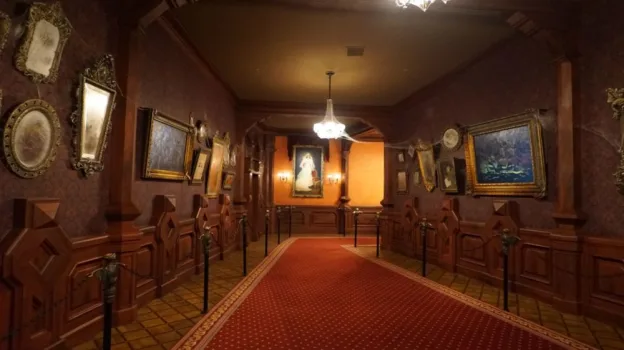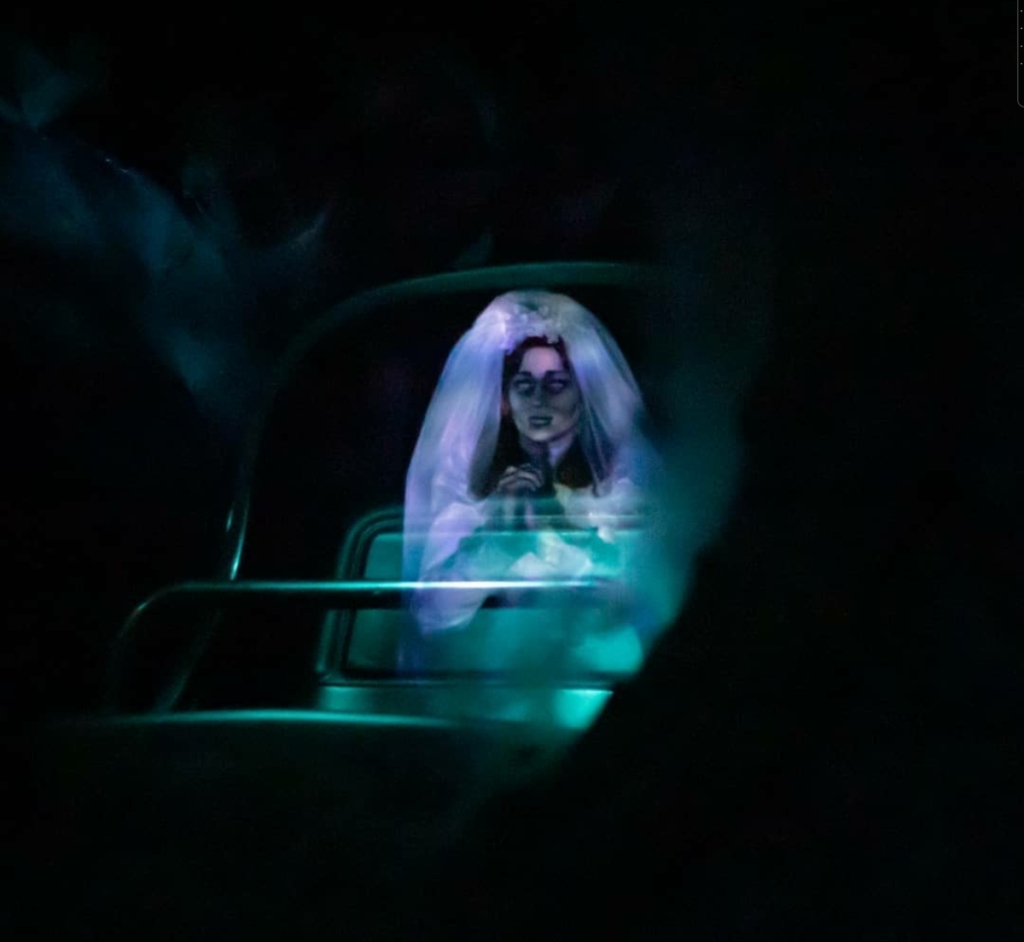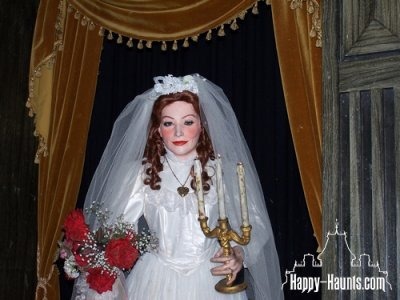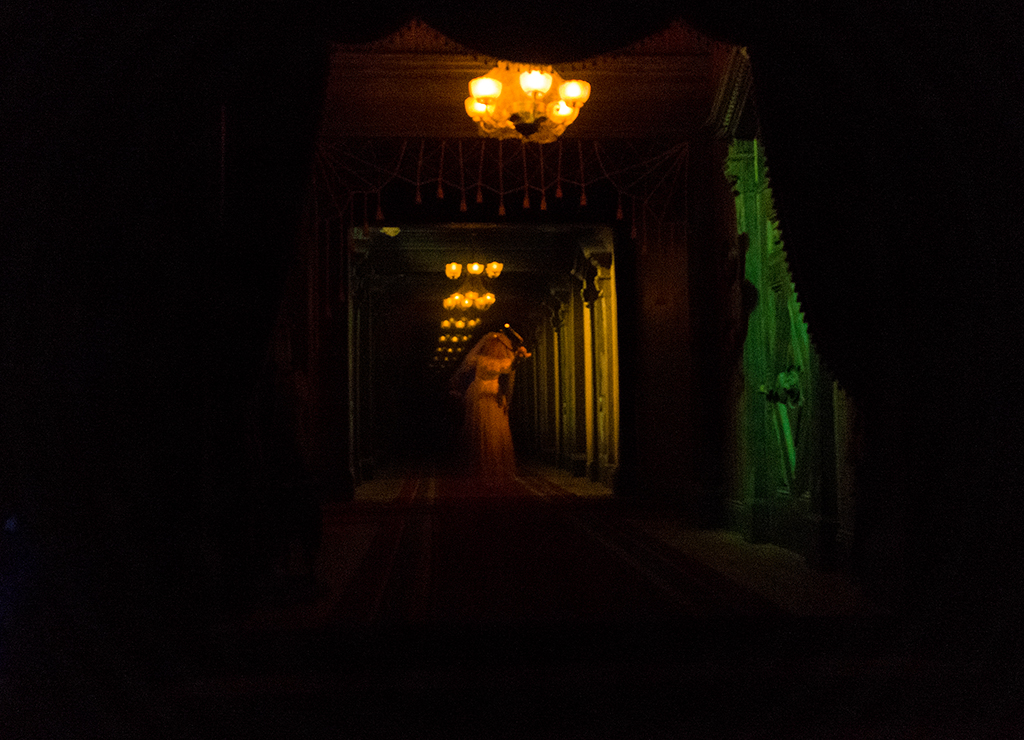Les théories ont toujours fait partie de l’intérêt et de la fascination du public pour Phantom Manor. Son histoire mystérieuse contient de nombreuses zones d’ombres que les fans tentent d’éclaircir depuis des années. La réhabilitation de l’attraction en 2019 a apporté quelques éléments de réponses mais a aussi créé de nouveaux questionnements. Voici quelques suggestions apportées par la nouvelle version que nous avons trouvées pertinentes de traiter. Veuillez garder à l’esprit qu’il ne s’agit que de théories, rien de ce qui est écrit dans cet article n’est officiel jusqu’à preuve du contraire. De plus, elles ne reflètent pas forcément les opinions de Walt Disney Imagineering ni celles des membres de notre équipe.
Rivalités familiales
Une des plus grandes questions générées par les changements de l’attraction concerne l’identité de l’un des duellistes du tableau de la Galerie. En revanche, il est clair que l’autre individu est Henry Ravenswood, reconnaissable à sa tenue et à son visage. Son adversaire, vêtu de vert, semble plus jeune mais issu de la même classe sociale aisée à en juger par ses vêtements. Aucun document public diffusé par Disney et aucun indice dans le ride ne semble renseigner sur ce gentleman. La seule piste vient des Haunted Mansion auxquelles ce portrait rend hommage. Dans la salle de bal de l’attraction originale, deux duellistes fantômes sortent des tableaux les représentant pour se tirer dessus. Une des tombes du cimetière de la version de Floride indique « RIP Mister Sewell, the victim of a Dirty Duel » et pourrait faire référence à l’un d’entre eux. Ce nom est un clin d’œil à l’Imagineer Bob Sewell. Cependant, il n’est nulle mention d’un Mister Sewell dans l’histoire de Phantom Manor ou quelque part à Thunder Mesa.
Certains pensent que le duelliste est un autre prétendant de Mélanie Ravenswood, d’autres qu’il s’agit d’un rival en affaires de son père. Quoi qu’il en soit, cet homme pourrait jouer un rôle dans l’histoire si il est figuré sur une peinture aux côtés de l’un des personnages principaux. Il semblerait étrange qu’un parfait inconnu soit représenté ainsi au manoir. A propos du manoir, ce dernier occupe une place centrale sur le tableau. Une lecture d’image basique pourrait laisser croire que la bâtisse est l’enjeu du duel. Rappelons que chez Walt Disney Imagineering, rien n’est laissé au hasard en termes de narration visuelle alors sa présence doit avoir une signification. La demeure est une propriété familiale, alors qui d’autre qu’un membre de la famille en réclamerait les droits ? Et il se trouve qu’il existe canoniquement d’autres Ravenswood…
Et si la nouvelle storyline avait réintroduit le personnage d’Arthur Ravenswood, le frère cadet d’Henry, via ce portrait? D’après le scénario original de Craig Fleming et Jeff Burke, les frères avaient fait fortune ensemble et vivaient au manoir avec leurs épouses. Arthur était l’oncle de Mélanie et il a survécu au tremblement de terre de 1860 qui a emporté Henry et Martha. Il mourut quelques années plus tard des suites d’une maladie et devait avoir une crypte au cimetière de Boot Hill. Les personnages d’Arthur et de sa femme, Gabrielle, ont été supprimés alors que l’attraction était encore en construction car jugés non essentiels à l’histoire de Phantom Manor. Comme la storyline a de nouveau changé en 2018, il est possible qu’Arthur ait été réintégré dans le but d’étoffer l’histoire de la famille Ravenswood et de rendre hommage à cette première version. Désormais, les frères auraient trouvé de l’or et fondé la Big Thunder Mining Company ensemble mais Henry était tellement cupide qu’il aurait généré des tensions familiales. Il en serait venu à se battre en duel avec son cadet et l’aurait tué de sang froid, devenant seul maître de la mine et du manoir. Et c’est ce que le tableau de la galerie représenterait, symbolisant à quel point Henry et vil et ajoutant une tragédie de plus à l’histoire de cette famille maudite.
Les deux Ghost Hosts
Là où les Haunted Mansion ont un ‘Ghost Host’, un hôte désincarné étant son propre personnage, il est communément admis que celui de la version parisienne est le Phantom lui-même. Originellement interprété par l’acteur Vincent Price, son discours en anglais a été remplacé par une version française doublée par Gérard Chevalier seulement quelques mois après l’ouverture de l’attraction en 1992. L’un comme l’autre s’adressaient au public à la première personne « I have more beauty to show you (…) Of course there’s always my way (…) I didn’t meant to frighten you prematurely »/ « Montrez-vous en pleine lumière, que je vous vois un peu (…) J’ai bien peur que vous soyez contraints de me suivre. Oh pardon, je ne voulais pas vous effrayer ».
L’audio de Vincent Price est partiellement revenu avec la réhabilitation de 2019, couplé à une nouvelle version française par Bernard Alane. Ce dernier évoque ‘le Fantôme des lieux’ et utilise parfois le pronom ‘nous’, mais jamais la première personne comparée à la voix anglaise. « Nous sommes ravis de vous accueillir (…) le Fantôme des lieux se fera un plaisir de vous aidez ». Ces tournures de phrases pourraient supposer que celui qui parle français n’est pas le Phantom. De plus, les deux voix ne se ressemblent pas. Elles se complètent, se font écho et répètent les mêmes informations. Et si il y avait en fait deux hôtes bien distincts pour accueillir les visiteurs ? Price interprétant le maître des lieux (d’autant plus qu’il lui prête son rire) et Alane un majordome… Jasper Jones peut-être ? Toujours fidèle à la famille Ravenswood, même dans la mort. Ce serait une façon efficace d’intégrer ce personnage dans l’attraction.
Vous êtes le Fiancé
Si, dans la nouvelle version, le Fiancé ne se balance plus au bout d’une corde, c’est parce qu’il serait en fait parmi nous et bien vivant. Cette théorie vient du fait que les visiteurs sont censés incarner le héros dans d’autres attractions Disney comme les premières versions de Snow White Scary Adventures ou Peter Pan’s Flight, justifiant le peu d’apparitions du personnage éponyme, voire son absence totale. Ainsi, nous verrions l’histoire de Phantom Manor à travers les yeux du Fiancé. Certaines lignes de l’hôte pourraient aller dans ce sens comme « Notre future mariée attend toujours l’homme de sa vie…des volontaires ? ». De plus, la présence d’un cinquième prétendant expliquerait aussi pourquoi Mélanie attend toujours dans sa robe blanche vu que les quatre autres sont déjà morts.
Après les évènements tragiques qui sont arrivés à la famille Ravenswood, le Fiancé reviendrait au manoir en quête de sa belle. La Stretching Room serait un piège tendu par Henry, annonçant clairement ses intentions hostiles à son égard. Les portraits des anciens prétendants ayant connu une fin atroce sonnent comme un avertissement sur le sort qu’il compte lui réserver. Si il ne trouve pas la sortie de cette pièce sans portes ni fenêtres, le Phantom se fera un plaisir de l’aider en lui passant la corde au cou ! Cette menace lui est faite directement. Il parvient quand même à sortir de cette salle mais les menaces du patriarche continuent sur les tableaux de la Galerie entre regards austères et scène de meurtre. Contrastant avec l’antipathie du père, le portrait de Mélanie en robe de mariée semble l’accueillir, comme une promesse de bonheur. Plus loin, en haut des escaliers, elle lui tourne le dos et ne semble pas le voir même si elle semble l’attendre et le cherche dans les scènes suivantes (couloir sans fin et salle de bal). Si elle ne peut pas le voir, c’est soit parce qu’elle est de dos, soit parce que le visiteur est dans une zone d’ombre. Le Phantom, en revanche, peut le voir. Il n’est jamais loin, regardant par-dessus l’épaule de la mariée et se moquant, rappelant sans cesse que sa fille est inaccessible. Henry Ravenswood parvient à attraper le Fiancé au cimetière et à l’envoyer dans le monde des morts où il le menace une dernière fois en lui présentant un cercueil ouvert qui lui est destiné. Mais le Fiancé arrive à ressortir des limbes, en ayant découvert ce qui est arrivé à ses prédécesseurs et en apprenant la terrible vérité : sa bien aimée est morte et a perdu l’esprit. Lorsqu’elle implore « Epouse-moi ! » d’une voix démente, c’est bien au visiteur qu’elle s’adresse. Et si le visiteur est censé incarner le Fiancé, ce n’est que dans la mort qu’elle le retrouve enfin… mais à quel prix ?
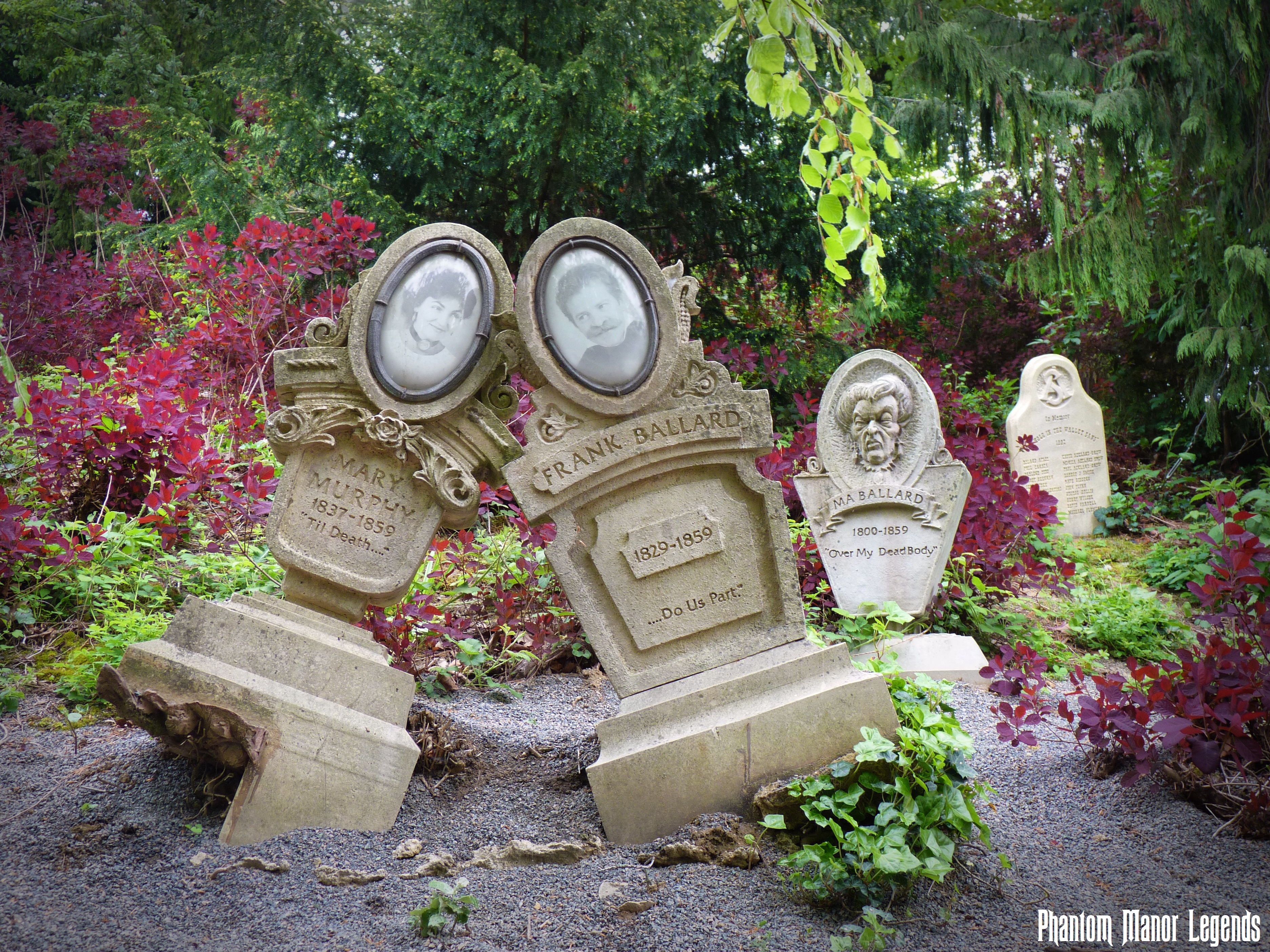
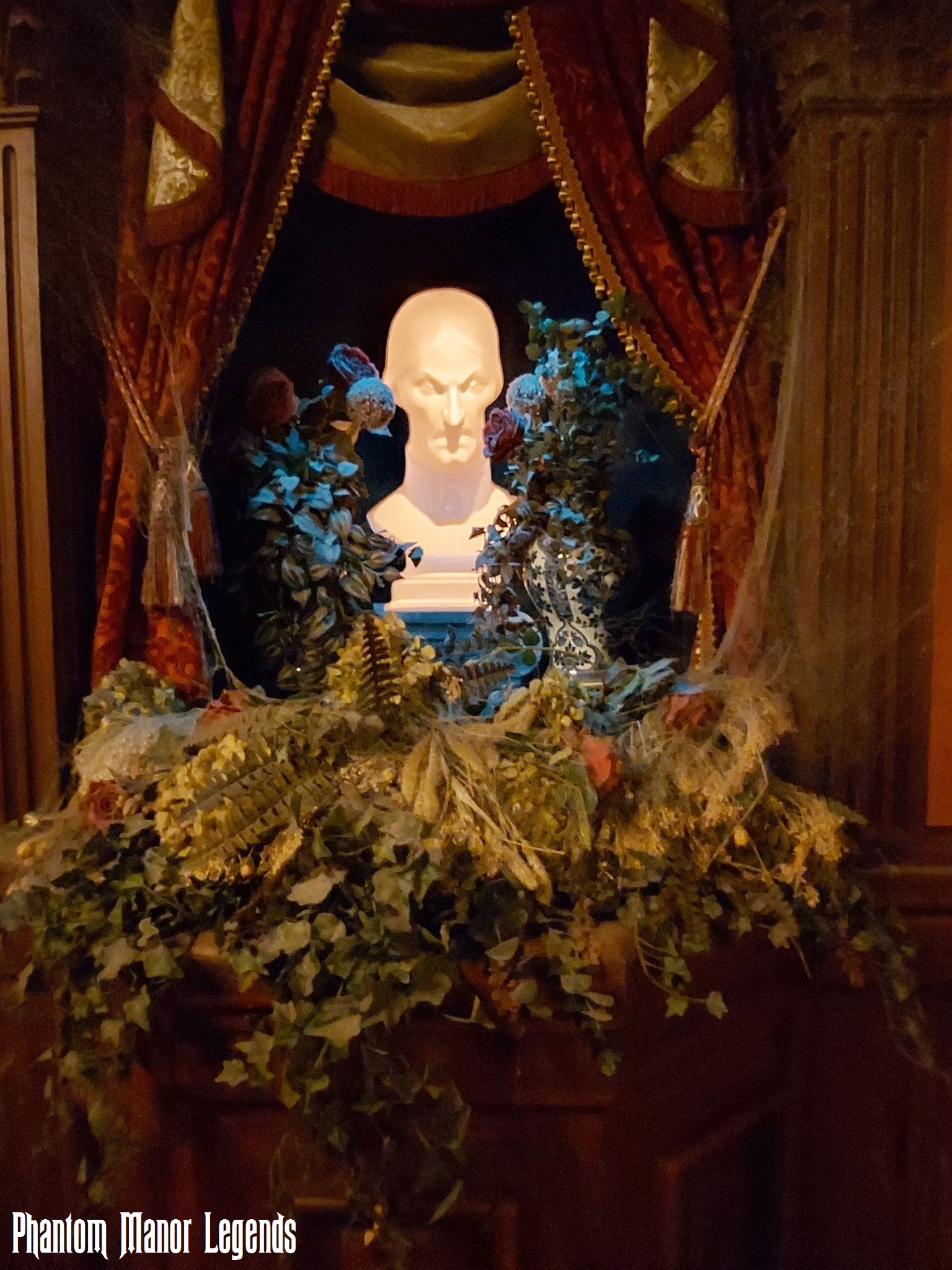
La famille de Martha Ravenswood
Boot Hill était le cimetière privé de la famille Ravenswood, ce qui implique que certains de leurs proches sont enterrés là. Suite à la mort d’Henry et Martha lors du tremblement de terre de 1860, le cimetière est devenu public et fut agrandi pour accueillir les sépultures des victimes de la catastrophe ainsi que tous les futurs défunts de Thunder Mesa. La plupart des tombes datent d’après 1960 mais il y en a quelques-unes qui sont antérieures, notamment celles des Ballard et de Mary Murphy, datées de 1859. Elles sont également plus travaillées que les autres, témoignant de l’appartenance de ces personnes à un milieu social aisé. Il était extrêmement rare et coûteux d’avoir sa photo sur une tombe à l’époque, surtout dans l’Ouest américain. Ainsi donc, ces deux familles étaient peut-être liées aux Ravenswood du côté de Martha. Elle pouvait porter le nom Murphy ou Ballard avant de se marier avec Henry. Autre argument en faveur de cette théorie : le portrait sculpté de Ma Ballard ressemble au buste situé dans la niche de la galerie, en face du grand escalier. Il ne serait pas surprenant d’avoir une représentation d’un membre de sa famille dans sa demeure, ce qui ferait de Martha, plus probablement, une Ballard. Cette théorie donne un peu plus de consistance au personnage de Martha Ravenswood en lui donnant une origine et en la reliant avec un élément de l’attraction. L’histoire de Frank et Mary, mariés contre la volonté d’un parent, fait écho à celle de Mélanie qui arrivera un an plus tard.
Les Cinq étapes du Deuil
Attention, celle théorie concerne surtout l’ancienne version de l’attraction (et est vraiment claquée au sol). Comme Phantom Manor est intimement lié au sujet de la mort, certains on fait un rapprochement entre les diverses apparitions de Mélanie Ravenswood dans le ride et les Cinq Etapes du Deuil. ‘Les Cinq Etapes du Deuil’ est un état psychologique formé par un cycle d’émotions que ressentent généralement les personnes suite à une annonce triste et sérieuse comme un décès ou une rupture amoureuse. On compte parmi ces ressentis, et dans cet ordre : le Déni, la Colère, le Marchandage, la Dépression et enfin l’Acceptation.
La première apparition physique de Mélanie représenterait le Déni. Alors que son Fiancé a déjà été assassiné par son propre père, elle est encore dans l’ignorance et accueille les visiteurs avec un sourire et une révérence. Il est, pour l’instant, inconcevable pour elle que son mariage soit perturbé.
Sa seconde apparition dans le couloir sans fin serait l’étape de la Colère. Bien que la mariée ne soit pas vraiment en colère, elle s’obstine à chercher son amoureux dans le manoir sans pour autant le trouver et ne songe pas encore au pire.
La Salle de Bal représenterait le Marchandage. A ce stade, Mélanie voit bien que quelque chose ne va pas. Elle a l’air plus en détresse mais pas encore désespérée. C’est dans ce genre d’état d’esprit que l’on serait apte à marchander (ici avec le Phantom), elle ferait probablement n’importe quoi pour voir son fiancé arriver d’un instant à l’autre.
La scène du Boudoir serait une métaphore claire de la Dépression. La mariée solitaire pleure devant son miroir, se laissant gagner par la tristesse. Elle a enfin compris qu’elle ne retrouvera pas son amour.
Et la dernière apparition de Mélanie, sous forme de squelette, serait l’étape finale, l’Acceptation. Morte et résignée, elle passe enfin à autre chose en devenant active, pointant la sortie du doigt pour sauver les visiteurs de l’emprise malfaisante du Phantom. Les cristaux pourraient être une métaphore de la pureté du personnage qui, après avoir subi autant de tourments, va enfin pouvoir trouver la paix.
Les théories contribuent parfois à réécrire l’histoire et étoffer la mythologie d’un sujet ou d’un univers. Les plus plausibles et les plus populaires peuvent parfois devenir officielles comme ce fut le cas, par exemple, pour les noms des Hitchhiking Ghosts de The Haunted Mansion. De même, nous pouvons nous poser la question suivante : Si la théorie disant qu’Henry Ravenswood est le Phantom n’avait pas été la plus répandue depuis 1992, est-ce que les changements opérés lors de la réhabilitation de 2018 auraient raconté une histoire différente ?
#Galaad Spectre
*******************************
Phantom Manor Fans Theories 2
Theories have always been part of the public’s interest and fascination with Phantom Manor. Its mysterious history contains many shadowed areas that fans have been trying to clarify for years. The attraction’s refurbishment in 2019 provided some answers but also created new questions. Here are some suggestions from the new version that we found relevant to discuss. Please keep in mind that these are only theories, nothing written in this article is official until proven otherwise. Moreover, they do not necessarily reflect the opinions of Walt Disney Imagineering or our team members.
Siblings Rivalry
One of the biggest questions generated by the changes in the attraction is about the identity of one of the duelists in the Gallery’s painting. Yet, it is clear that the other man is Henry Ravenswood, recognizable by his outfit and his face. His opponent, dressed in green, seems younger but from the same high social class judging by his clothes. No public document released by Disney and no clue in the ride seems to give informations about this gentleman. The only hint comes from the Haunted Mansion to which this portrait pays tribute. In the ballroom of the original attraction, two ghostly duelists come out of their paintings to shoot at each other. One of the graveyard stones in the Florida version says “RIP Mister Sewell, the victim of a Dirty Duel” and could refer to one of them. The name is a nod to the Imagineer Bob Sewell. However, there is no mention of a Mister Sewell in the history of Phantom Manor or anywhere in Thunder Mesa.
Some think the duelist is another suitor of Melanie Ravenswood, others think it is a business rival of her father. In any case, this man could play a role in the story if he is depicted on a painting alongside one of the main characters. It seems strange that a complete stranger is represented like this, in front of the manor. About the manor, the latter occupies a central place on the painting. A basic image reading might suggest that the building is the prize of the duel. Remember that at Walt Disney Imagineering, nothing is left to chance in terms of visual narration so its presence must have a meaning. The house is family property, so who else but a family member would claim the rights? And it so happens that there are canonically other Ravenswood…
What if the new storyline had reintroduced the character of Arthur Ravenswood, Henry’s younger brother, via this portrait? According to the original script by Craig Fleming and Jeff Burke, the brothers had made a fortune together and lived at the manor with their wives. Arthur was Melanie’s uncle and survived the 1860 earthquake that killed Henry and Martha. He passed away a few years later from an illness and was to have a crypt at Boot Hill Cemetery. The characters of Arthur and his wife, Gabrielle, were removed while the attraction was still under construction because deemed not essential to the story of Phantom Manor. As the storyline changed again in 2018, it is possible that Arthur was reinstated in order to flesh out the history of the Ravenswood family and pay tribute to this first version. By now, the brothers would have found gold and founded the Big Thunder Mining Company together but Henry was so greedy that he would have generated conflicts in the family. He would have fought in a duel with his younger brother and killed him in cold blood, becoming the sole master of the mine and the manor. And that’s what the gallery painting would represent, symbolizing how evil Henry is and adding yet another tragedy to the history of this cursed family.
The Two Ghost Hosts
Where the Haunted Mansion has a ‘Ghost Host’, a disembodied entity being his own character, it is commonly accepted that the Parisian version is the Phantom itself. Originally voiced by actor Vincent Price, his speech in English was replaced by a French version dubbed by Gérard Chevalier only a few months after the opening of the attraction in 1992. Both addressed to the public in first person “I have more beauty to show you (…) Of course there’s always my way (…) I didn’t meant to frighten you prematurely”/ “Montrez-vous en pleine lumière que je vous voie un peu (…) J’ai bien peur que vous soyez contraints de me suivre. Oh pardon, je ne voulais pas vous effrayer.”
Vincent Price’s audio has partially returned with the 2019 rehabilitation, mixed with a new French version by Bernard Alane. The latter evokes ‘Le Fantôme des lieux’ and sometimes uses the pronoun ‘we’ (nous), but never the first person compared to the English voice. “Nous sommes ravis de vous accueillir (…) Le fantôme des lieux se fera un plaisir de vous aider.”. These phrases could imply that the French speaker is not the Phantom. Moreover, the two voices are not alike. They complement each other, echo and repeat the same information. What if there were in fact two very distinct hosts to welcome visitors? Price being the master of the place (especially since he gives him his laugh) and Alane being a butler… Jasper Jones can-be? Always faithful to the Ravenswood family, even in death. This would be an effective way to put this character into the attraction.
You are the Groom
If, in the new version, the Fiancé no longer swings with a rope around his neck, it’s because he would actually be among us and alive. This theory comes from the fact that visitors are supposed to play the hero in other Disney attractions such as the early versions of Snow White Scary Adventures or Peter Pan’s Flight, justifying the few appearances of the character, or even his total absence. Thus, we would see the story of Phantom Manor through the eyes of the Groom. Some of the host’s lines might go in this direction, such as “Notre future Mariée attend toujours l’homme de sa vie…des volontaires ? ‘’ (Our bride-to-be is still waiting for the man of her life… any volunteers?) In addition, the presence of a fifth suitor would also explain why Melanie is still waiting in her wedding dress since the other four are already dead.
After the tragic events that happened to the Ravenswood family, the Fiancé would return to the manor in search of his beloved. The Stretching Room would be a trap set by Henry, clearly announcing his hostile intentions towards him. The portraits of the former suitors who had known an atrocious end sound like a warning about the fate the ghost intends to reserve for him. If he does not find the exit of this room without doors and windows, the Phantom will be happy to help him by putting the noose around his neck! This threat is made directly to him. He still manages to leave this room but the patriarch’s threats continue on the Gallery’s paintings via austere looks and murder scene on the paintings. Contrasting with the father’s antipathy, the portrait of Melanie in her wedding dress seems to welcome him, as a promise of bliss. Further on, at the top of the stairs, she turns her back on him and does not seem to see him even if she seems to be waiting for him and is looking for him in the following scenes (endless corridor and ballroom). If she can’t see him, it’s either because she has her back turned or because the visitor is in a dark zone. The Phantom, on the other hand, can see him. He is never far away, looking over the bride’s shoulder and laughing, constantly reminding that her daughter is inaccessible. Henry Ravenswood manages to catch the Fiancé in the cemetery and send him to the underworld where he threatens him one last time by presenting him with an open coffin. But the Groom manages to escape from limbo, discovering what happened to his predecessors in the process and learning the terrible truth: his beloved died and have lost her mind. When she implores « Marry me! » in a demented voice, she addresses the visitor. And if the visitor is supposed to embody the Fiancé, it is only in death that she finally finds him… but at what cost?


Martha Ravenswood’s family
Boot Hill was the private cemetery of the Ravenswood family, which implies that some of their relatives are buried there. Following the death of Henry and Martha in the 1860 earthquake, the cemetery became public and was expanded to accommodate the graves of the victims of the disaster as well as all future deaths in Thunder Mesa. Most of the graves date from after 1960, but there are a few earlier ones, including those of the Ballard and Mary Murphy, dated 1859. They are also more decorated than others, testifying to their belonging to a high social environment. It was extremely rare and expensive to have your picture on a grave at the time, especially in the American West. So, these two families may have been related to the Ravenswood on Martha’s side. She could have be called Murphy or Ballard before marrying Henry. Another argument in favour of this theory is that the sculpted portrait of Ma Ballard resembles the bust in the gallery niche facing the grand staircase. It would not be surprising to have a representation of a family member in her home, which would make Martha, more likely, a Ballard. This theory gives a little more consistency to the character of Martha Ravenswood by giving it an origin and connecting her with an element of attraction. The story of Frank and Mary, married against the will of a parent, echoes that of Melanie a year later.
The Five Stages of Grief
Warning, this theory mainly concerns the old version of the ride (and is really over the top). As Phantom Manor is intimately related to the subject of death, some have drawn a connection between the various appearances of Melanie Ravenswood in the ride and the Five Stages of Grief. “The Five Stages of Grief” is a psychological state formed by a cycle of emotions that people usually feel after a sad and serious announcement like a death or a heartbreak. Among these feelings, and in this order: Denial, Anger, Bargaining, Depression,and finally, Acceptance.
Melanie’s first physical appearance would represent Denial. While her fiancé has already been murdered by her own father, she is still in ignorance and welcomes visitors with a smile and a reverence. It is, for the moment, inconceivable to her that her marriage would be disturbed.
His second appearance in the endless hallway would be the stage of Anger. Although the bride is not really angry, she persists in looking for her lover in the manor without finding him and does not even think about the worst yet.
The Ballroom would represent Bargaining. At this point, Melanie can see that something is wrong. She looks more distressed but not yet desperate. It is in this kind of state of mind that one would be able to bargain (here with the Phantom), she would probably do anything to see her fiancé arrive any moment.
The Boudoir scene would be a clear metaphor for Depression. The lonely bride cries in front of her mirror, letting herself be overcome by sadness. She has finally understood that she will not see her love again.
And Melanie’s last appearance, in the form of a skeleton, would be the final stage: Acceptance. Dead and resigned, she finally moves on to something else by becoming active, pointing her finger out to save the visitors from the evil hold of the Phantom. The crystals could be a metaphor for the purity of the character who, after suffering so much torment, will finally find peace.
Theories sometimes help rewrite history and add to the lore of a subject or universe. The most plausible and popular ones can sometimes become official as that was the case, for example, for the names of the Hitchhiking Ghosts of The Haunted Mansion. Similarly, we can ask ourselves the following question: If the theory saying that Henry Ravenswood is the Phantom had not been the most widespread since 1992, would the changes made during the 2018 refurbishment have told a different story?
#Galaad Spectre
SOURCES
https://hauntedmansion.fandom.com/wiki/Sewell
https://www.youtube.com/watch?v=mb2RSWLfAmo
https://fr.wikipedia.org/wiki/Mod%C3%A8le_de_K%C3%BCbler-Ross
Phantom Manor : Pictures & Videos

